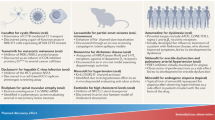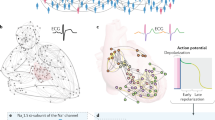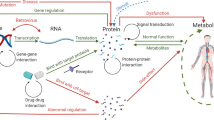Abstract
The hope of the rapid translation of 'genes to drugs' has foundered on the reality that disease biology is complex, and that drug development must be driven by insights into biological responses. Systems biology aims to describe and to understand the operation of complex biological systems and ultimately to develop predictive models of human disease. Although meaningful molecular level models of human cell and tissue function are a distant goal, systems biology efforts are already influencing drug discovery. Large-scale gene, protein and metabolite measurements ('omics') dramatically accelerate hypothesis generation and testing in disease models. Computer simulations integrating knowledge of organ and system-level responses help prioritize _targets and design clinical trials. Automation of complex primary human cell–based assay systems designed to capture emergent properties can now integrate a broad range of disease-relevant human biology into the drug discovery process, informing _target and compound validation, lead optimization, and clinical indication selection. These systems biology approaches promise to improve decision making in pharmaceutical development.
This is a preview of subscription content, access via your institution
Access options
Subscribe to this journal
Receive 12 print issues and online access
We are sorry, but there is no personal subscription option available for your country.
Buy this article
- Purchase on SpringerLink
- Instant access to full article PDF
Prices may be subject to local taxes which are calculated during checkout



Similar content being viewed by others
References
DiMasi, J.A., Hansen, R.W. & Grabowski, H.G. The price of innovation: new estimates of drug development costs. J. Health Econ. 22, 151–185 (2003).
Ideker, T., Galitski, T. & Hood, L. A new approach to decoding life: systems biology. Annu. Rev. Genomics Hum. Genet. 2, 343–372 (2001).
Ideker, T. & Lauffenburger, D. Building with a scaffold: emerging strategies for high- to low-level cellular modeling. Trends Biotechnol. 21, 255–262 (2003).
Hunter, P.J. & Borg, T.K. Integration from proteins to organs: the Physiome Project. Nat. Rev. Mol. Cell Biol. 4, 237–243 (2003).
Kulkarni, N.H. et al. Gene expression profiles classify different classes of bone therapies: PTH, Alendronate and SERMs, Poster 307, 31st European Symposium on Calicified Tissue, June 5, 2004, Nice, France; http://www.ectsoc.org/nice2004/abstracts.htm#onl
Weston, A.D. & Hood, L. Systems biology, proteomics, and the future of health care: toward predictive, preventative, and personalized medicine. J. Proteome. Res. 3, 179–196 (2004).
Clish, C.B. et al. Integrative biological analysis of the APOE*3-leiden transgenic mouse. Omics 8, 3–13 (2004).
Kantor, A.B. et al. Biomarker discovery by comprehensive phenotyping for autoimmune diseases. Clin. Immunol. 111, 186–195 (2004).
Davidson, E.H. et al. A genomic regulatory network for development. Science 295, 1669–1678 (2002).
Ideker, T. et al. Integrated genomic and proteomic analyses of a systematically perturbed metabolic network. Science 292, 929–934 (2001).
Covert, M.W., Knight, E.M., Reed, J.L., Herrgard, M.J. & Palsson, B.O. Integrating high-throughput and computational data elucidates bacterial networks. Nature 429, 92–96 (2004).
Hughes, T.R. et al. Functional discovery via a compendium of expression profiles. Cell 102, 109–126 (2000).
Crampin, E.J. et al. Computational physiology and the Physiome Project. Exp. Physiol 89, 1–26 (2004).
Noble, D. Modeling the heart—from genes to cells to the whole organ. Science 295, 1678–1682 (2002).
Bassingthwaighte, J.B. & Vinnakota, K.C. The computational integrated myocyte: a view into the virtual heart. Ann. NY Acad. Sci. 1015, 391–404 (2004).
Musante, C.J., Lewis, A.K. & Hall, K. Small- and large-scale biosimulation applied to drug discovery and development. Drug Discov. Today 7, S192–S196 (2002).
Stokes, C.L. et al. A computer model of chronic asthma with application to clinical studies: example of treatment of exercise-induced asthma. J. Allergy. Clin. Immunol. 107, 933 (2001).
Lewis, A.K. et al. The roles of cells and mediators in a computer model of chronic asthma. Inter. Arch. Allergy Immunol. 124, 282–286 (2001).
Leckie, M.J. et al. Effects of an interleukin-5 blocking monoclonal antibody on eosinophils, airway hyper-responsiveness, and the late asthmatic response. Lancet 356, 2144–2148 (2000).
Bergman, R.N., Ider, Y.Z., Bowden, C.R. & Cobelli, C. Quantitative estimation of insulin sensitivity. Am. J. Physiol. 236, E667–E677 (1979).
Kansal, A.R. Modeling approaches to type 2 diabetes. Diabetes Technol. Ther. 6, 39–47 (2004).
Eungdamrong, N.J. & Iyengar, R. Modeling cell signaling networks. Biol. Cell 96, 355–362 (2004).
Bhalla, U.S. & Iyengar, R. Emergent properties of networks of biological signaling pathways. Science 283, 381–387 (1999).
Kelley, B.P. et al. PathBLAST: a tool for alignment of protein interaction networks. Nucleic Acids Res. 32, W83–W88 (2004).
Coleman, R.A., Bowen, W.P., Baines, I.A., Woodrooffe, A.J. & Brown, A.M. Use of human tissue in ADME and safety profiling of development candidates. Drug Discov. Today 6, 1116–1126 (2001).
Chanda, S.K. et al. Genome-scale functional profiling of the mammalian AP-1 signaling pathway. Proc. Natl. Acad. Sci. USA 100, 12153–12158 (2003).
Haggarty, S.J., Koeller, K.M., Wong, J.C., Butcher, R.A. & Schreiber, S.L. Multidimensional chemical genetic analysis of diversity-oriented synthesis-derived deacetylase inhibitors using cell-based assays. Chem. Biol. 10, 383–396 (2003).
Borisy, A.A. et al. Systematic discovery of multicomponent therapeutics. Proc. Natl. Acad. Sci. USA 100, 7977–7982 (2003).
Marton, M.J. et al. Drug _target validation and identification of secondary drug _target effects using DNA microarrays. Nat. Med. 4, 1293–1301 (1998).
Kunkel, E.J. et al. An integrative biology approach for analysis of drug action in models of human vascular inflammation. FASEB J. 18, 1279–1281 (2004).
Kunkel, E.J. et al. Rapid structure-activity and selectivity analysis of kinase inhibitors by BioMAP analysis in complex human primary cell-based models. Assay Drug Dev. Technol. 2, 431–441 (2004).
Plavec, I. et al. Method for analyzing signaling networks in complex cellular systems. Proc. Natl. Acad. Sci. USA 101, 1223–1228 (2004).
Mach, F. Statins as novel immunomodulators: from cell to potential clinical benefit. Thromb. Haemost. 90, 607–610 (2003).
Christopher, R. et al. Data-driven computer simulation of human cancer cell. Ann. NY Acad. Sci. 1020, 132–153 (2004).
Wiley, H.S., Shvartsman, S.Y. & Lauffenburger, D.A. Computational modeling of the EGF-receptor system: a paradigm for systems biology. Trends Cell Biol. 13, 43–50 (2003).
Schoeberl, B., Eichler-Jonsson, C., Gilles, E.D. & Muller, G. Computational modeling of the dynamics of the MAP kinase cascade activated by surface and internalized EGF receptors. Nat. Biotechnol. 20, 370–375 (2002).
Eker, S. et al. Pathway logic: symbolic analysis of biological signaling. Pac. Symp. Biocomput. 7, 400–412 (2002).
Cho, K.H., Shin, S.Y., Lee, H.W. & Wolkenhauer, O. Investigations into the analysis and modeling of the TNF alpha-mediated NF-kappa B-signaling pathway. Genome Res. 13, 2413–2422 (2003).
Hoffmann, A., Levchenko, A., Scott, M.L. & Baltimore, D. The IkappaB-NF-kappaB signaling module: temporal control and selective gene activation. Science 298, 1241–1245 (2002).
Acknowledgements
Writing of this review was supported in part by SBIR grants (R44 AI048255 and R43 AI049048) to BioSeek, Inc., and by NIH grants to E.C.B. The authors thank Evangelos Hytopoulos and Ivan Plavec for thoughtful criticism and input.
Author information
Authors and Affiliations
Corresponding author
Ethics declarations
Competing interests
E.J.K. is an employee, E.L.B. is a cofounder and vice president of research, and E.C.B. is a cofounder, chair of the SAB and member of the board of directors of BioSeek.
Rights and permissions
About this article
Cite this article
Butcher, E., Berg, E. & Kunkel, E. Systems biology in drug discovery. Nat Biotechnol 22, 1253–1259 (2004). https://doi.org/10.1038/nbt1017
Published:
Issue Date:
DOI: https://doi.org/10.1038/nbt1017
This article is cited by
-
Identifying patterns to uncover the importance of biological pathways on known drug repurposing scenarios
BMC Genomics (2024)
-
Systems biology informed neural networks (SBINN) predict response and novel combinations for PD-1 checkpoint blockade
Communications Biology (2021)
-
Circadian rhythms: influence on physiology, pharmacology, and therapeutic interventions
Journal of Pharmacokinetics and Pharmacodynamics (2021)
-
Towards reproducible computational drug discovery
Journal of Cheminformatics (2020)



